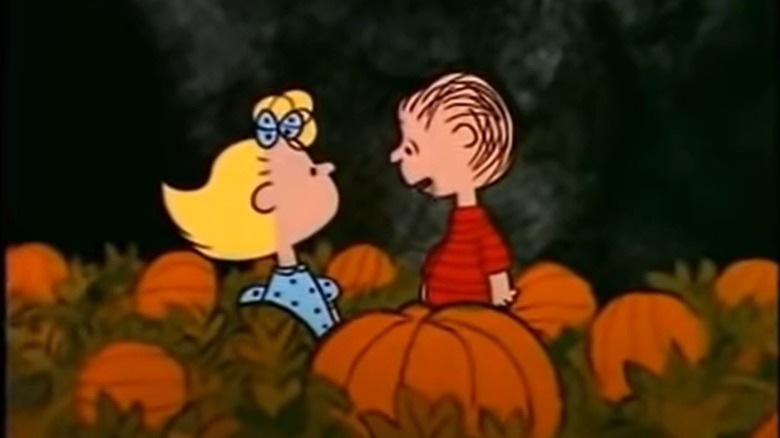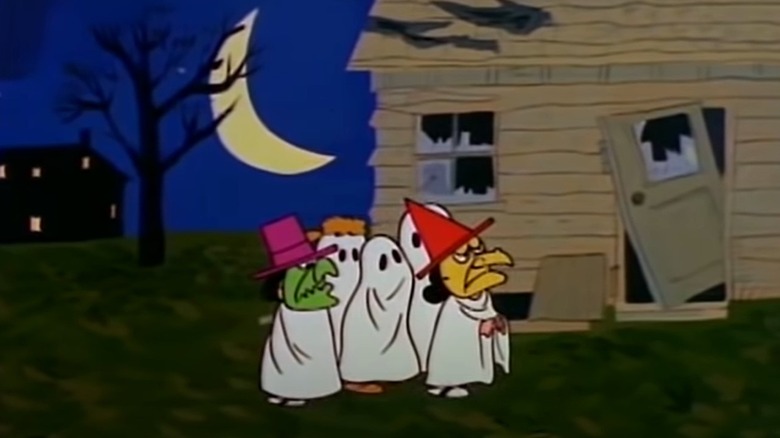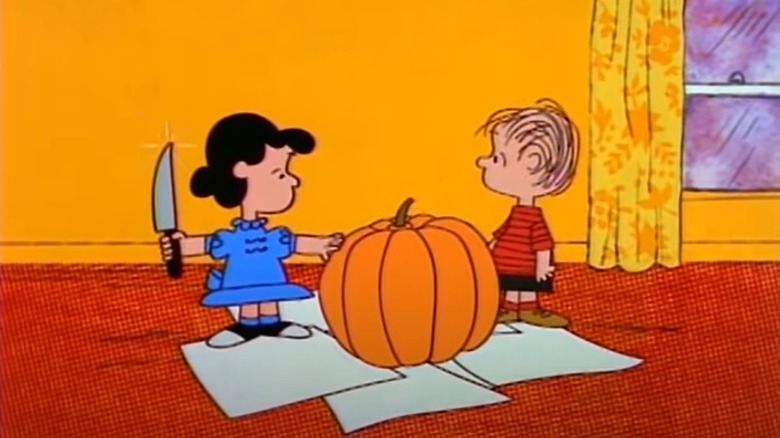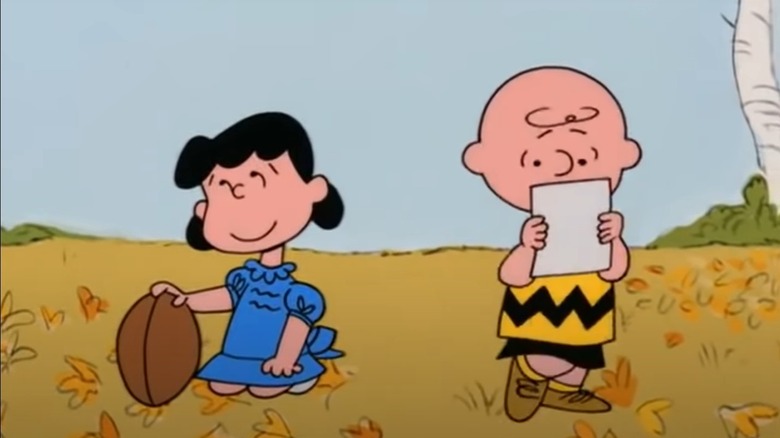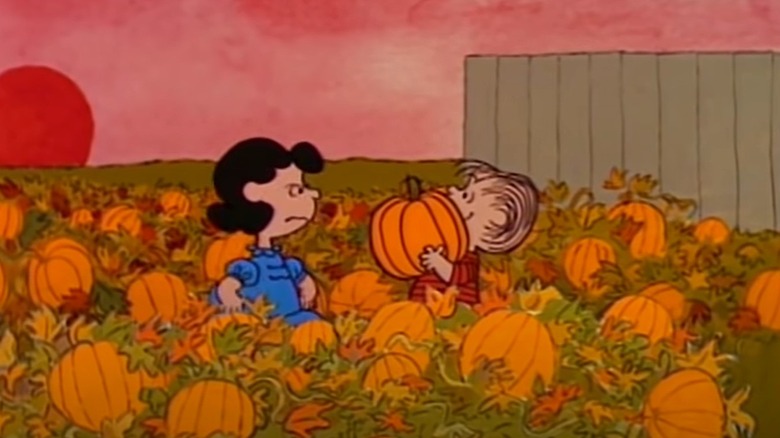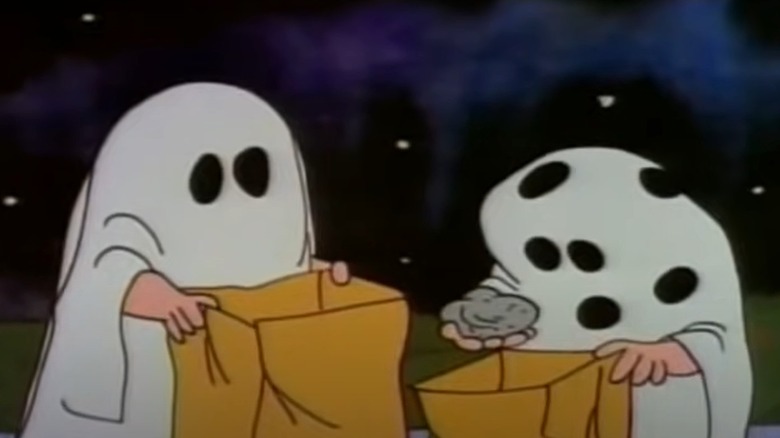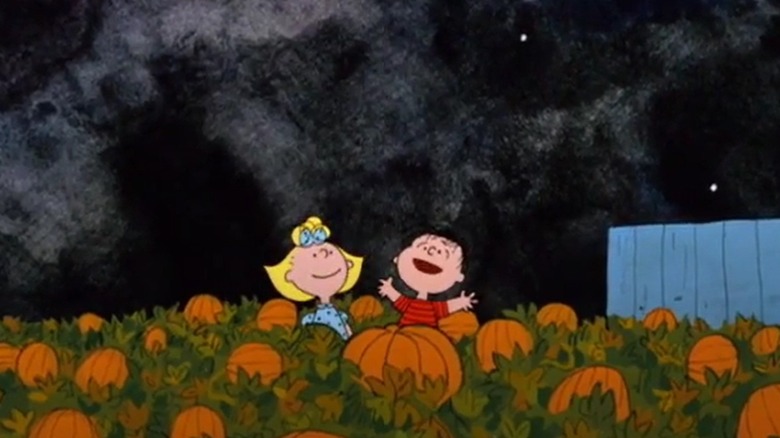Things In It's The Great Pumpkin, Charlie Brown You Only Notice As An Adult
Along with apple-picking, leaf-peeping, and Halloween decorating, watching seasonal movies and TV shows is always a cherished October tradition. One of the most beloved of these is "It's the Great Pumpkin, Charlie Brown." The 1966 TV special features the "Peanuts" gang enjoying Halloween fun ... well, most of them. Linus, along with Charlie Brown's sister, Sally, spends the night in a local pumpkin patch in the innocent belief that the Great Pumpkin will appear and give gifts to all the good children. What happens comes as a surprise to everyone, especially the delighted audience.
After decades of airing on network TV, in 2020 the show was bought by Apple TV+, which aired it exclusively on its streaming platform. That enraged fans who didn't want to pay for the privilege of seeing Charlie Brown in action. Fortunately, the network relented this year and has allowed PBS to air it to the general public as a one-time event on October 24 at 7:30 p.m. ET (via USA Today). It's a must-watch for families, but the grown-ups in the viewing audience might notice a few issues about the familiar plot and characters that come off a little strange to our 21st-century sensibilities. Here are some examples:
Costumes used to be a lot simpler
When Charlie Brown and the gang go out candy collecting (or "tricks or treats," as they put it), there isn't a single Disney princess, Marvel Universe superhero or TV cartoon character in sight. Lucy puts on a witch mask — because one's costume should reflect the opposite of one's personality, she announces — and everyone else goes as a basic white-sheet-with-holes ghost. (Well, in Charlie Brown's case, he "had a little trouble with the scissors" and ends up looking like Swiss cheese.)
Back in the mid-'60s, dime-store character costumes like the Beatles, Flipper, and "The Man From U.N.C.L.E." were popular (via MeTV), despite the fact that the outfits were flimsy and horribly uncomfortable. (Those plastic masks always pinched around your eyes.) But homemade costumes like Lucy's and Pig-Pen's were just as common. Plenty of kids would put on mom or dad's old clothes to go on their candy rounds, or get creative with face paint to become a clown. These days, you'd be more likely to see Lucy going as Winifred Sanderson from "Hocus Pocus" and Charlie Brown as a Scoops Ahoy server from "Stranger Things."
The kids are totally free-range
Part of the charm of "Peanuts" has always been its child-centric world. Adults are occasionally referenced or spoken to (like the teacher Miss Othmar), but they're never seen, and they never drive the action of the comic strip or cartoons. We accept this reality because the characters are so appealing, but every so often it becomes jarring to our grown-up eyes. For instance, the gang goes trick-or-treating around the neighborhood on their own, with no parents standing guard at the curb. How many moms today can watch the show without thinking, "Does nobody here worry about kidnappers?"
Lucy, in particular, is given more independence than a typical child her age. (Per Peanuts Fandom, the older "Peanuts" children are around six or seven.) She's in charge of choosing the family's pumpkin and carving it — with a large sharp knife, mind you. She leads the group on their candy rounds and takes charge at Violet's Halloween party afterward. Then at 4:00 the next morning, it's Lucy who wakes up and brings her shivering brother in from the pumpkin patch. No wonder she's so grouchy all the time — all that responsibility takes its toll, you know.
These kids know a lot about the law
For a girl who barely knows how to tie her shoes, little Sally Brown is awfully savvy about legal matters. When Lucy explains the concept of trick-or-treating, Sally's first reaction is to ask, "Are you sure it's legal?" When Lucy assures her it is, Sally replies, "I wouldn't want to be accused of taking part in a rumble." (via IMDb) Later on, when it becomes clear that the Great Pumpkin is a no-show, she threatens to sue Linus for making her miss out on tricks or treats. "You owe me restitution!" she screams.
Lucy is another character who has the makings of a future lawyer. Note how she cons Charlie Brown into trying to punt her football by offering "a signed document testifying that I promise not to pull it away." The legal-looking paper looks good to Charlie Brown, so he goes for it — and Lucy once again pulls the ball away at the last minute. As her friend lies dazed on the ground, Lucy slyly says, "Peculiar thing about this document: It was never notarized."
A LOT of bullying goes on
Harder to ignore is the cruelty throughout "Great Pumpkin." Charlie Brown is the perpetual outcast, and his so-called friends never let him forget it. In the first few minutes of the show, Lucy plays her annual prank on hapless Charlie, yanking the football away in mid-kick. (It's a wonder the poor boy doesn't suffer permanent spinal cord damage.) From there, it just goes downhill. Lucy and Violet ask Charlie Brown to be their "model" for their jack-o-lantern, then draw the design on the back of his head. Violet sends him an invitation to her Halloween party, but Lucy explains that he was supposed to have been on the "don't invite" list.
Linus gets his share of not-so-good grief, too. All the kids — including his own sister — mock him for waiting for the Great Pumpkin instead of collecting gum and popcorn balls. Little Sally smacks him around after she misses out on trick-or-treat, even though nobody forced her to keep him company. Even parents who grew up loving the show are looking at it with new eyes. The reviews on Common Sense Media, a site that evaluates kids' entertainment, include comments like, "I was a bit taken aback by how horribly the characters treat each other and their use of name-calling." Another mom remarked, "I do not feel that this should be for little children while they are growing, developing and learning about how we treat others."
The (unseen) adults are awful, too
Granted, kids can be cruel. But what the adults do in "Great Pumpkin" is worse. Sure, they toss treats into the kids' pillowcases when the doorbell rings: apples, popcorn balls, chocolate bars, and packages of gum. (Mini-candy bars and allergy-safe alternatives weren't a thing 50 years ago.) But what do they give to good ol' Charlie Brown? Rocks. Rocks! Is there some kind of local tradition where homeowners randomly prank kids with stones along with the treats? Or is every grown-up in this town a sicko determined to make this one child's life miserable?
Let's not forget Linus and Lucy's parents, either. Did they ever try to set Linus straight on the existence of the Great Pumpkin? Instead, they let their child sit all night in a pumpkin patch — dressed in a T-shirt in the middle of autumn — and then forget to check in on him. Lucy is the one who finally saves him from hypothermia. So where were the senior Van Pelts when all this was happening? Did they drink too many Mummy Martinis at their own Halloween party and pass out on the couch? Or were they passing around rocks for the neighbors to toss into Charlie Brown's bag? If this were real life, the neighbors would be calling child protective services and mom-shaming Mrs. Van Pelt on Facebook.
The show is a metaphor for faith
Still, if you can look past the bad behavior and legal disputes, at the heart of "It's the Great Pumpkin, Charlie Brown" is a deeper religious theme. Charles Schulz was a devout Christian who put many gentle religious references in his "Peanuts" strips (via The Atlantic). During the making of "A Charlie Brown Christmas," Schulz insisted on including the scene in which Linus explains the true meaning of Christmas by reciting from the New Testament (via Christian Headlines). The production team finally agreed, and the show became an Emmy-winning classic.
In "Great Pumpkin," Linus once again acts as the gang's spiritual anchor. Despite his friends' teasing, he maintains his trust in a powerful being whom he's never seen. When Charlie Brown asks, "When are you going to stop believing in something that isn't true?" Linus retorts, "When you stop believing in that fellow with the red suit and white beard who goes 'Ho, ho, ho.'" (via Subslike Script). He gladly gives up trick-or-treating and Violet's party to sit in a chilly garden all night, confident that he'll finally get a glimpse of the gift-giving gourd.
And despite one moment of doubt — he slips up and says "if the Great Pumpkin comes" instead of "when" — Linus never truly gives up hope. In the closing scene, we see him declaring, "Just wait till next year, Charlie Brown. You'll see! ... The Great Pumpkin will appear! And I'll be waiting for him! I'll be there!"
Maybe it wouldn't be such a bad thing if we all had a little of Linus' innocent faith.
